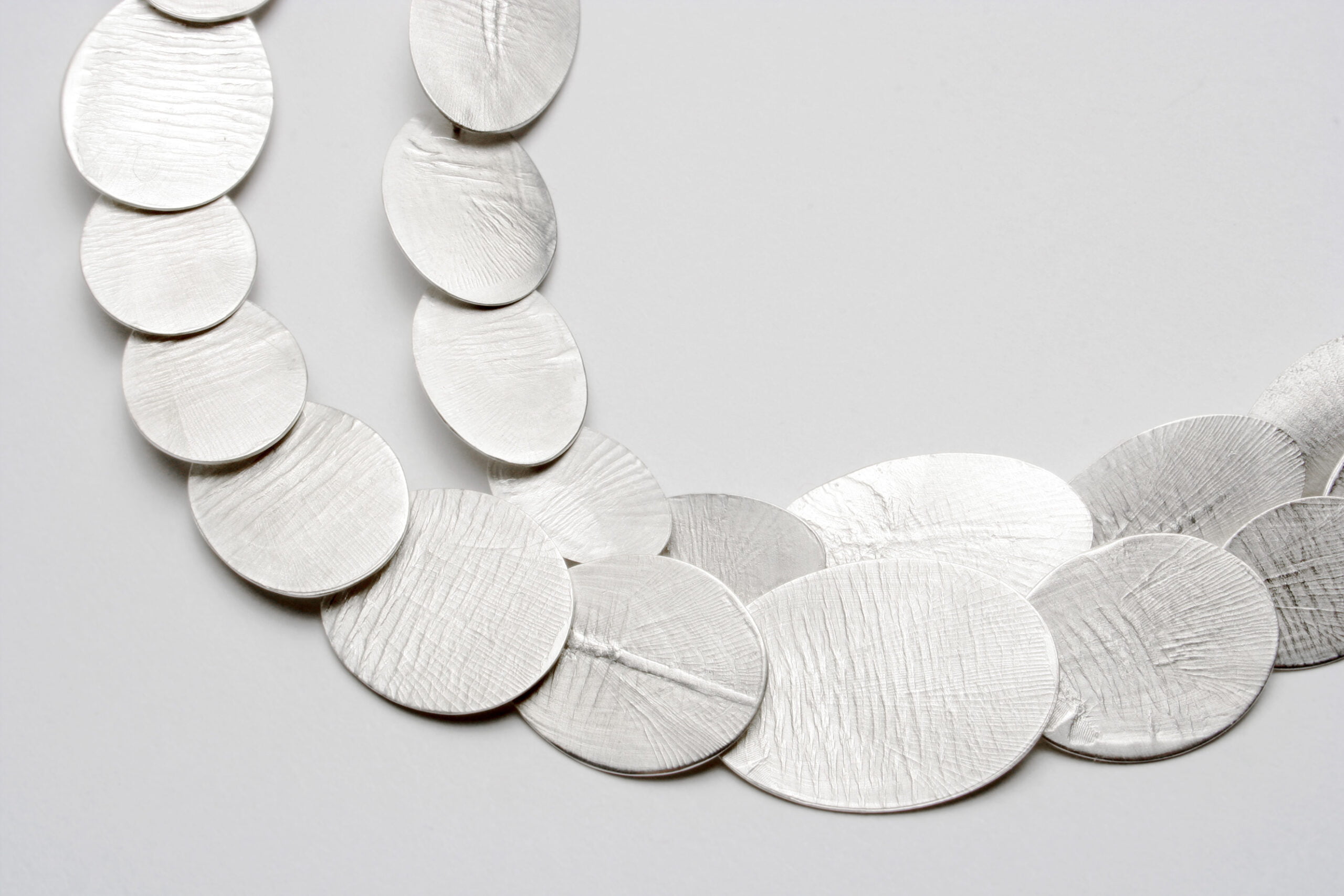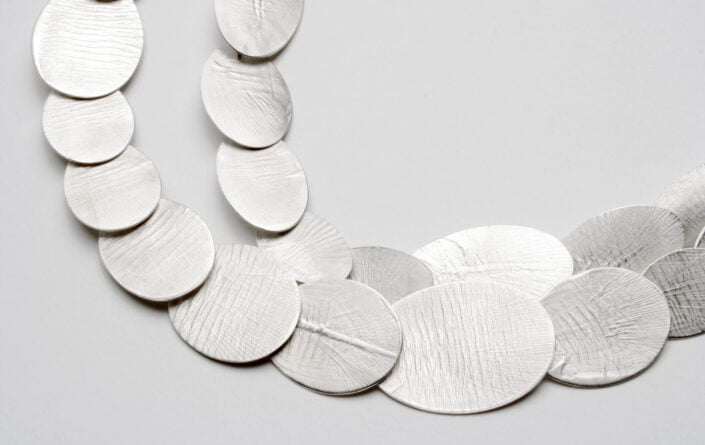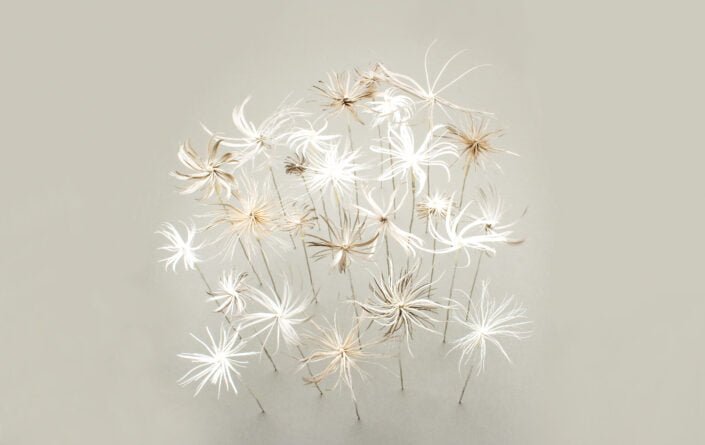Nicky Hepburn
Most of my day to day work at the bench is about attention to detail and small things. My natural inclination is to notice tiny, reflective, colourful or unusual shapes. To notice these things involves looking down. When I started walking I noticed my focus was drawn to the micro-environments at my feet, then gradually up to higher levels.
Referencing found objects such as cuttlefish and kelp on the tide line, the impressions of insect galls on leaves, forest litter, fish scales, shells, seed pods and native plants, this work is an observation and celebration of cycles and natural growth patterns encountered along the walk, from the Cobboboonee Forest to the Discovery Bay coastline.
Sharing the experience with other artists broadened my focus to encompass other ways of seeing. I looked up more often. My work for this exhibition comes from the small things I noticed on the walk.
Nicky Hepburn
Nicky Hepburn’s practice is an exploration into transformation. Working with careful regard to the physicality of her materials, she reinterprets organic specimens collected and observed along the Walk to create almost wearable, museum-like artefacts. In a fusion of body and place, the ephemeral is recast to reflect slowness and absorption. Hepburn’s rings, armbands, bracelets and spheres resonate with the energy of the landscape. Her considered response to texture, colour, pattern and movement guides the formal progression and surface intonation of these works to evoke the endless, subtle variations found in the natural world.
Walk also includes works created by Nicky Hepburn in collaboration with Ilka White.
Interview with Nicky Hepburn
Why did you choose to be involved in the Great South West Walk Art Project?
There were several reasons. It was another chance to work collaboratively with Ilka White, who I had successfully worked with before. It was also a chance to immerse myself in an environment for an extended period and to then gauge my reactions through my work. I had never been involved with an art project with this many fellow artists who practice in so many varied mediums, and it was also a chance to further my arts practice by pushing myself a little further and learning from fellow artists. Walking is also a favourite pastime.
How would you describe your artistic practice from concept to making?
The process of making my art varies depending on what I am working on. Often it is a found object that stimulates a form and technique. At other times it can be a reaction to a poem that informs my response. I will then play with the best way to make my response come alive by trying to capture an essence of the initial influence by using whatever material and form I think best suits the concept. I am sometimes able to resolve many of my ideas by drawing and recording variables and by research. For this project it was unique because I was a long way from my studio and it was impossible to research and play with possible materials, concepts and techniques. My concepts for Walk were developed through playing with a mixture of material, emotion, colour and texture that I felt best described my reactions to walking that particular environment. Informing those concepts were the many photos I took, collected litter and fragments of things along the way, and my journal and recordings, which contained thoughts, feelings, facts, observations and drawings.
Did you have any preconceived ideas or plans for your work before embarking on the Walk? If so, what were they and how did your work evolve?
Aside from pursuing some collaborative pieces with Ilka I had no preconceived ideas at all. Most days were full of walking; only breaking for meals. So most of my time was spent recording in my journal thoughts and drawings, taking the occasional photo, collecting bits and pieces that I noticed along the way and now and then recording my thoughts on a small recorder.
What is it about the Great South West Walk that inspired you?
It is hard to list all the things that had an effect on me in terms of inspiration. It is also hard to pinpoint whether it was only the landscape or the company or a combination. It was all of these things, but in terms of the body of work that I made, it was the small things I noticed on the Walk that informed my work. Things like a canopy of twinkling light through the leaves, the mirror quality of the Glenelg River, the shape of curled, shed bark fallen from the trees, insect galls on leaves, forest litter [and] fish scales collected on the banks of the Glenelg.
You have said that the Walk helped you to see differently. What do you mean by this and how has it impacted on your work and practice?
My natural instinct is to notice small shiny or unusually shaped things, often on the ground but certainly by looking down. Sharing the experience with other artists broadened my focus to encompass other ways of seeing. I looked up more often. When I started the Walk, I noticed my focus was drawn to the micro-environments at my feet, then through contact with fellow artists and naturalists, my interest was drawn up to higher levels. I became absorbed in the colours, textures, patterns, light, shade and forms of the passing landscapes. By this time I was focusing at all different levels of the landscape – not only those at my feet.
When did you start making work for this exhibition? When did it stop being ‘note taking’ and become ‘making’?
About a month after I returned from the Walk I started to think about my interpretation of some of my feelings and how I could tell my story of response. I found the Walk had impacted on my day-to-day routine and it was more difficult to focus on making. After catching up with the daily things that had been on hold for a couple of months or so, I turned my mind to playing with the many found fragments that I had collected along the way. My playing continued on and off for many months, my ideas and forms morphing all the time. When the real making started is hard to pinpoint, but I think I started to make prototypes about a year ago.
What did you hope to capture in your work?
I hoped to bring to life some of those often missed and taken for granted things we all see and collect when we spend time in the forest and by the sea. To draw attention to the small everyday beauty of our landscape that often gets overlooked, in fact it often gets discarded as litter or just forgotten about when we are finished with it.
What were the major challenges you faced on the Walk?
I should have answered this question straight after the Walk; in retrospect I think the answer is different. I really wanted more time to ‘dwell’ in different places. By this I mean to soak up particular feelings, to do more drawing, to focus on certain aspects that caught my interest. Some days we didn’t have the time to even stop and draw.
What do you hope the viewer will take away from your work and the exhibition?
A sense of identity with the landscape. A desire to immerse themselves in the environment to experience what we have, the sights and sounds of place.
You have mentioned that you and Ilka White have worked together in the past and that you intended to collaborate on works for Walk. How would you describe your collaborative process?
Yes, we have collaborated before and wanted a chance to further that opportunity. The Walk allowed us to experience together the same landscape and then create our work. In the past we have worked together by interpreting our feelings about certain objects, textures and issues, however this time we were placed within the environment and we were able to communicate our observations to each other, of the moment, rather than at another time and removed from that space. I think the experience is different. Collaboration is a unique experience and can result in vastly different works from your own independent work. Our works were a result of an overwhelming reaction to material and place and the form and technique were a result of our field of expertise. Weather Vanes was a true collaboration of all the processes. We both made all the different parts from beginning to end.
2007Most of my day to day work at the bench is about attention to detail and small things. My natural inclination is to notice tiny, reflective, colourful or unusual shapes. To notice these things involves looking down. When I started walking I noticed my focus was drawn to the micro-environments at my feet, then gradually up to higher levels.
Referencing found objects such as cuttlefish and kelp on the tide line, the impressions of insect galls on leaves, forest litter, fish scales, shells, seed pods and native plants, this work is an observation and celebration of cycles and natural growth patterns encountered along the walk, from the Cobboboonee Forest to the Discovery Bay coastline.
Sharing the experience with other artists broadened my focus to encompass other ways of seeing. I looked up more often. My work for this exhibition comes from the small things I noticed on the walk.
Nicky Hepburn
Nicky Hepburn’s practice is an exploration into transformation. Working with careful regard to the physicality of her materials, she reinterprets organic specimens collected and observed along the Walk to create almost wearable, museum-like artefacts. In a fusion of body and place, the ephemeral is recast to reflect slowness and absorption. Hepburn’s rings, armbands, bracelets and spheres resonate with the energy of the landscape. Her considered response to texture, colour, pattern and movement guides the formal progression and surface intonation of these works to evoke the endless, subtle variations found in the natural world.
Walk also includes works created by Nicky Hepburn in collaboration with Ilka White.
Interview with Nicky Hepburn
Why did you choose to be involved in the Great South West Walk Art Project?
There were several reasons. It was another chance to work collaboratively with Ilka White, who I had successfully worked with before. It was also a chance to immerse myself in an environment for an extended period and to then gauge my reactions through my work. I had never been involved with an art project with this many fellow artists who practice in so many varied mediums, and it was also a chance to further my arts practice by pushing myself a little further and learning from fellow artists. Walking is also a favourite pastime.
How would you describe your artistic practice from concept to making?
The process of making my art varies depending on what I am working on. Often it is a found object that stimulates a form and technique. At other times it can be a reaction to a poem that informs my response. I will then play with the best way to make my response come alive by trying to capture an essence of the initial influence by using whatever material and form I think best suits the concept. I am sometimes able to resolve many of my ideas by drawing and recording variables and by research. For this project it was unique because I was a long way from my studio and it was impossible to research and play with possible materials, concepts and techniques. My concepts for Walk were developed through playing with a mixture of material, emotion, colour and texture that I felt best described my reactions to walking that particular environment. Informing those concepts were the many photos I took, collected litter and fragments of things along the way, and my journal and recordings, which contained thoughts, feelings, facts, observations and drawings.
Did you have any preconceived ideas or plans for your work before embarking on the Walk? If so, what were they and how did your work evolve?
Aside from pursuing some collaborative pieces with Ilka I had no preconceived ideas at all. Most days were full of walking; only breaking for meals. So most of my time was spent recording in my journal thoughts and drawings, taking the occasional photo, collecting bits and pieces that I noticed along the way and now and then recording my thoughts on a small recorder.
What is it about the Great South West Walk that inspired you?
It is hard to list all the things that had an effect on me in terms of inspiration. It is also hard to pinpoint whether it was only the landscape or the company or a combination. It was all of these things, but in terms of the body of work that I made, it was the small things I noticed on the Walk that informed my work. Things like a canopy of twinkling light through the leaves, the mirror quality of the Glenelg River, the shape of curled, shed bark fallen from the trees, insect galls on leaves, forest litter [and] fish scales collected on the banks of the Glenelg.
You have said that the Walk helped you to see differently. What do you mean by this and how has it impacted on your work and practice?
My natural instinct is to notice small shiny or unusually shaped things, often on the ground but certainly by looking down. Sharing the experience with other artists broadened my focus to encompass other ways of seeing. I looked up more often. When I started the Walk, I noticed my focus was drawn to the micro-environments at my feet, then through contact with fellow artists and naturalists, my interest was drawn up to higher levels. I became absorbed in the colours, textures, patterns, light, shade and forms of the passing landscapes. By this time I was focusing at all different levels of the landscape – not only those at my feet.
When did you start making work for this exhibition? When did it stop being ‘note taking’ and become ‘making’?
About a month after I returned from the Walk I started to think about my interpretation of some of my feelings and how I could tell my story of response. I found the Walk had impacted on my day-to-day routine and it was more difficult to focus on making. After catching up with the daily things that had been on hold for a couple of months or so, I turned my mind to playing with the many found fragments that I had collected along the way. My playing continued on and off for many months, my ideas and forms morphing all the time. When the real making started is hard to pinpoint, but I think I started to make prototypes about a year ago.
What did you hope to capture in your work?
I hoped to bring to life some of those often missed and taken for granted things we all see and collect when we spend time in the forest and by the sea. To draw attention to the small everyday beauty of our landscape that often gets overlooked, in fact it often gets discarded as litter or just forgotten about when we are finished with it.
What were the major challenges you faced on the Walk?
I should have answered this question straight after the Walk; in retrospect I think the answer is different. I really wanted more time to ‘dwell’ in different places. By this I mean to soak up particular feelings, to do more drawing, to focus on certain aspects that caught my interest. Some days we didn’t have the time to even stop and draw.
What do you hope the viewer will take away from your work and the exhibition?
A sense of identity with the landscape. A desire to immerse themselves in the environment to experience what we have, the sights and sounds of place.
You have mentioned that you and Ilka White have worked together in the past and that you intended to collaborate on works for Walk. How would you describe your collaborative process?
Yes, we have collaborated before and wanted a chance to further that opportunity. The Walk allowed us to experience together the same landscape and then create our work. In the past we have worked together by interpreting our feelings about certain objects, textures and issues, however this time we were placed within the environment and we were able to communicate our observations to each other, of the moment, rather than at another time and removed from that space. I think the experience is different. Collaboration is a unique experience and can result in vastly different works from your own independent work. Our works were a result of an overwhelming reaction to material and place and the form and technique were a result of our field of expertise. Weather Vanes was a true collaboration of all the processes. We both made all the different parts from beginning to end.
2007



